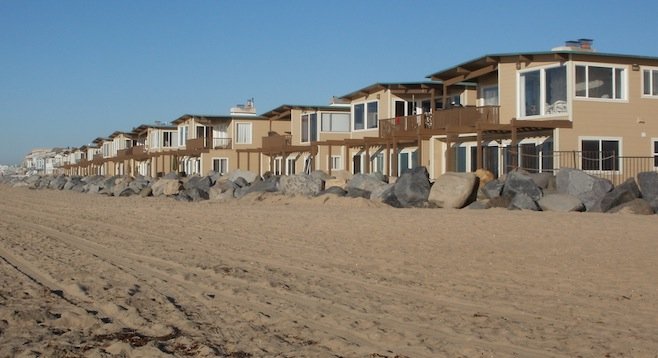 Facebook
Facebook
 X
X
 Instagram
Instagram
 TikTok
TikTok
 Youtube
Youtube

Five of the 20 Imperial Beach homeowners and groups that filed damage claims for the flooding that followed SANDAG's beach replenishment project were turned away on December 20. SANDAG's board voted that the five could not file late claims with the multigovermental agency that handled the project.
In September and October 2012, SANDAG contractors moved 450,000 cubic yards of sand onto .8 mile of beach. By November, the condominium buildings on Seacoast Drive south of Imperial Beach Boulevard had started experiencing problems from seawater pooling next to and underneath the buildings — including in underground parking garages. The flooding and standing water continued through the end of January, owners said.
"When SANDAG did the sand replenishment, the water was flooding under our foundations," said Robin Clegg, who serves on the board of the 44-unit Boca Rio Homeowners Association. "We were inundated with seawater around our foundation and we're not sure what will happen in the future — the long-term effects of saltwater around our rebar and cast-iron pipes, and any wiring in the garages."
Most of the claimants indicated that they do not yet know the value of the claims, but used a base of $10,000 or more, according to SANDAG documents. Some asked SANDAG in their claims to use its expertise to examine the properties and assess if there would be long-term damage or if the building infrastructure had been damaged.
How the sand was banked and whether or not the buildings would have flooded anyway — since they are near sea level — are among the issues disputed in the claims process, according to SANDAG officials. But to Clegg and the other homeowners, the cause was clear.
"They did this without considering the implications; they fooled with Mother Nature to a point where Mother Nature pushed back," she said. "The saltwater ate the SDG&E wires that were underground so three buildings, the electricity wasn't working. Every water meter, every streetlightswasn't working. Palm trees died."
Under government regulations, in order to sue for damages, claimants must first file claims with the government and have them rejected. It's not clear what will happen with the alleged damages of the five homeowners, including Clegg and her husband, and their HOA.
"We've gotten a lawyer," Clegg said. "We intend to pursue this."


Five of the 20 Imperial Beach homeowners and groups that filed damage claims for the flooding that followed SANDAG's beach replenishment project were turned away on December 20. SANDAG's board voted that the five could not file late claims with the multigovermental agency that handled the project.
In September and October 2012, SANDAG contractors moved 450,000 cubic yards of sand onto .8 mile of beach. By November, the condominium buildings on Seacoast Drive south of Imperial Beach Boulevard had started experiencing problems from seawater pooling next to and underneath the buildings — including in underground parking garages. The flooding and standing water continued through the end of January, owners said.
"When SANDAG did the sand replenishment, the water was flooding under our foundations," said Robin Clegg, who serves on the board of the 44-unit Boca Rio Homeowners Association. "We were inundated with seawater around our foundation and we're not sure what will happen in the future — the long-term effects of saltwater around our rebar and cast-iron pipes, and any wiring in the garages."
Most of the claimants indicated that they do not yet know the value of the claims, but used a base of $10,000 or more, according to SANDAG documents. Some asked SANDAG in their claims to use its expertise to examine the properties and assess if there would be long-term damage or if the building infrastructure had been damaged.
How the sand was banked and whether or not the buildings would have flooded anyway — since they are near sea level — are among the issues disputed in the claims process, according to SANDAG officials. But to Clegg and the other homeowners, the cause was clear.
"They did this without considering the implications; they fooled with Mother Nature to a point where Mother Nature pushed back," she said. "The saltwater ate the SDG&E wires that were underground so three buildings, the electricity wasn't working. Every water meter, every streetlightswasn't working. Palm trees died."
Under government regulations, in order to sue for damages, claimants must first file claims with the government and have them rejected. It's not clear what will happen with the alleged damages of the five homeowners, including Clegg and her husband, and their HOA.
"We've gotten a lawyer," Clegg said. "We intend to pursue this."
Comments